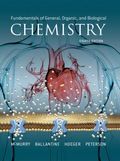
Interpretation: The electron configuration of given ions to be predicted.
Concept Introduction:
Formation of ions:
Atom possesses equal number of protons and electrons and remains electrically neutral. By gaining (accepting electrons) or losing (donating electrons) one or more electrons, converts the neutral atom into a charged particle called IONS.
Cation: The loss of one or more electrons by a neutral atom leaves the atom positively charged called cation.
Anion: The gain of one or more electrons by a neutral atom leaves the neutral atom negatively charged called anion.
The symbolic representation of ions:
The electrons are reside in the principal quantum number ‘n’; by losing and gaining electron, reduces and increases in the electron count in the electronic configuration of the atom; for a cation adding positive charge as a superscript to the symbol of the element and for the anion adding negative charge as superscript to the symbol of the element.
Want to see the full answer?
Check out a sample textbook solution
Chapter 3 Solutions
EBK FUNDAMENTALS OF GENERAL, ORGANIC, A
- Write the molecular formula for the compound that exhbits a molecular ion at M+ = 84.0574. Assume that C, H, N, and O might be present, and use the exact masses below:arrow_forwardApply the formula for the differences in electronegativities, for the following molecules, and define whether they are polar covalent, nonpolar covalent or ionic. Taking into account that: Non-polar covalent: greater than or equal to 0 but less than 0.7 Polar covalent: greater than or equal to 0.7 but less than 1.7 ionic: greater than 1.7 A)NO B)KCI C)F2 C)AsOarrow_forwardElement Z forms an ion Z 3+, which contains 31 protons. What is the identity of Z, and how many electrons does Z3+have?arrow_forward
- Balance the following (fictional) chemical equations by supplying the correct coefficient. Do not leave any space blank (in other words, write in 1 if you would be leaving it blank): R(OZ)2 - RY2+ Z20 a) ZY+ b) D2 (g) + L2 (g) – DL3 (e)arrow_forwardThe following equation shows the reaction of baking soda (NaHCO3) and hydrochloric acid (HCl). NaHCO3+HCl → CO2+H2O+NaCl If you have 3.0 grams of NaHCO3, how many moles of HCl are needed for a complete relation?arrow_forwardGiven Reactants: Sodium Hydroxide (NaOH) Potassium Permanganate (KMnO4) Glucose (C₆H₁₂O₆) Find the following: 1. Molecular equation 2. Total ionic equation 3. Net ionic equationarrow_forward
- Write a skeletal equation for the following chemical change. Solid lithium reacts with chlorine gas to produce solid lithium chloride.arrow_forwardNicotine, an alkaloid in the nightshade family of plants that is mainly responsible for the addictive nature of cigarettes, contains 74.02% C, 8.710% H, and 17.27% N. If 40.57 g of nicotine contains 0.2500 mol nicotine, what is the molecular formula?arrow_forwardWrite net ionic equations for the following reactions:arrow_forward
- Calculate the coulomb energy for the following three nuclei using the semi-empirical mass formula. a) 19F b) 48Tİ c) 63Cuarrow_forward(i) MnO is basic whereas Mn207 is acidic in nature. Why? (ii) Transition metals form alloys. Why? (iii) Complete the following equation: 2MnO4 + 4KOH + O2 ———>arrow_forwardDerive the Henderson – Hasselbach Equation. [H*][A¯] Ка— [НА] Molecular Weight: H = 1 g/mol C= 12 g/mol N=14 g/mol O = 16 g/mol Cl= 35.45 g/molarrow_forward
 Principles Of Radiographic Imaging: An Art And A ...Health & NutritionISBN:9781337711067Author:Richard R. Carlton, Arlene M. Adler, Vesna BalacPublisher:Cengage Learning
Principles Of Radiographic Imaging: An Art And A ...Health & NutritionISBN:9781337711067Author:Richard R. Carlton, Arlene M. Adler, Vesna BalacPublisher:Cengage Learning
